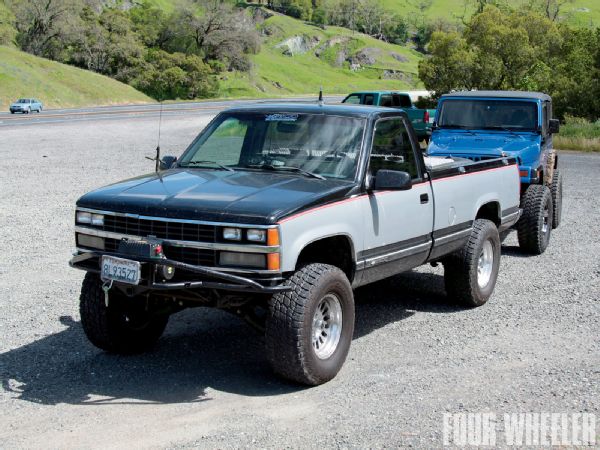
The GM Corporate 14-bolt axle is one of the most favored rear-ends you can find used for under $500. Most wrecking yards have a pile of them in stock, and due to a substantial production run across all variations of HD pickup trucks and SUVs, chances are you can find the specific type you need with minimum effort. Enthusiasts love the full-floating eight-lug 14-bolt because it features a massive 10.5-inch ring gear, and a very strong pinion design that incorporates support bearings on each side of the pinion's teeth-awesome for minimizing pinion deflection under high torque applications.
 Our donor Chevy Silverado was built in 1989, wore the 2500 badging, and featured six-lug wheels. GM offered this configuration to bridge the GVWR gap between the 1500 and the 2500 series. Today these light-duty 3/4-tons are easy to spot in wrecking yards-just count the lug nuts and cross-reference the model badging on the door.
Our donor Chevy Silverado was built in 1989, wore the 2500 badging, and featured six-lug wheels. GM offered this configuration to bridge the GVWR gap between the 1500 and the 2500 series. Today these light-duty 3/4-tons are easy to spot in wrecking yards-just count the lug nuts and cross-reference the model badging on the door.
However, most people are not aware of the less common six-lug, semi-floating version of the 14-bolt axle. GM called it the "9.5" 14-bolt (after its ring-gear diameter) and offered it exclusively in light-duty 3/4-ton pickups built between 1986 and '93. While not as strong as its eight-lug cousin, the semi-floating 14-bolt rearend does sport some noteworthy attributes. For instance, the all-important width measurement from wheel mounting surface to wheel mounting surface is 67 inches-perfect for most 1/2-ton pickups. Generally, you wouldn't even need to change mounting brackets to bolt this housing right into the rear of a 1/2-ton GM pickup because the leaf spring architecture is identical. We like the fact that the ring gear measures out at a healthy 9 1/2-inch diameter, and the 33-spline axleshafts have a 1.370-inch diameter-a sure improvement in strength over the typical 1/2-ton shafts. This less grown-up version of the 14-bolt may not have the extra pinion support bearing of its eight-lug cousin, but it's rated to handle 5,000 lb-ft of torque, so it's no lightweight either. Moreover, aftermarket suppliers such as Randy's Ring and Pinion offer all the upgrade goodies you need to make this rear end survive with up to 37-inch-tall rubber. As a result, owners of virtually any GM 1/2-ton pickup offered with six-lug wheels can benefit greatly from a semi-float 14-bolt axle upgrade.
Here is the kicker: Thanks to the semi-floating design, a factory-style wheel will bolt right up. This means you do not have to spend your hard-earned cash on eight-lug wheels to get vast improvements in overall axle strength. We think these axles are the cat's meow for trucks equipped from the factory with 10- or 12-bolt rear axles. Yes, you'll need to ensure proper gearing for your truck, but know that most semi-floating 14-bolt axles have the common 1/2-ton 3.73:1 gear ratio already installed, rather than the popular 4.10:1 ratio found in the full-floating version-so if you already have 3.73:1 gearing, you may save additional money. Otherwise, depending on U-bolt length and pinion yoke type, the job is a no-brainer.
For this story, we borrowed a friend's '89 Chevy Silverado 3/4-ton with the less-common semi-floating axle installed from the factory (this is the donor truck you would want to find at a wrecking yard). Follow along now as our friends from Right Gear and Axle of Salinas, California, help us fortify a semi-floater for 35s, light towing and occasional trail work.
PhotosView Slideshow




 PhotosView Slideshow
PhotosView Slideshow




